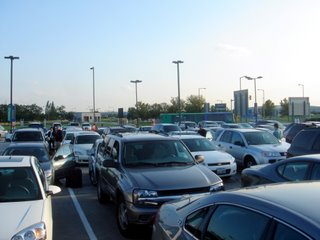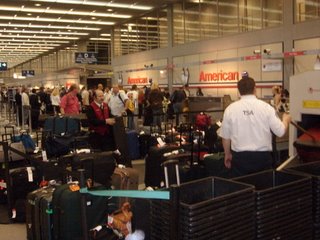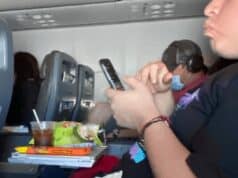I know not everybody travels, so y'all might not be concerned about attempts to see lean (or NON lean) practices in the travel world. But, I travel almost weekly, so this is one “gemba” I see quite a bit. One reason I like highlighting lean in the travel world is that it's something we can all experience and it forces us to look at a process outside of our normal work environment. I will do one more travel post this week, about hotel cleaning quality, staffing, and management attitudes — then maybe I'll give the travel thing a rest.
Good System Design
I received an email from blog reader Walt, who pointed out some nice system design at the Atlanta airport long-term parking. Are there “lean” lessons here? Yes, if you consider not wasting your customers' time to be lean (ala Lean Solutions, by Womack and Jones) and if you consider not wasting gas and time driving around looking for a parking spot to be lean. It's nice to appreciate good system design when you see it — when things “just work” in a way that's a bit surprisingly and delightful.
Walt's email:
I recently traveled out of Atlanta Hartsfield Airport, and was extremely impressed with their long-term parking process.
Upon entering the long-term parking area, they directed me to the only row that they were filling at that time. I thought that it was odd that only one row was open until I realized that they were filling (essentially “topping off”) partially-filled rows, one row at a time. All of the rows to the north of me were completely full and all of the rows to the south of me were partially full. They eliminated the need for customers to drive all over the lot to search for a vacant spot.
There was a small queue of shuttle-buses waiting, with one bus ready to pick you as you exited your car. They eliminated the need to walk to, and wait at, a central area to be picked up.
When you entered the shuttle bus, they gave you a slip of paper with your aisle number written on it so that you could find your car easier when you returned. Poka yoke!!!
When I returned to ATL four days later, I pulled out my car location slip and gave it to the driver when I was picked up at the terminal. He sorted all of the slips and dropped us off at our car in the best order for reducing wait.
I watched the shuttle bus after all of the travelers were let off, and the bus drove over to the pick-up queue to get ready to get more travelers. This reduced the distance that the buses drove empty.
Someone did a great job in eliminating a lot of waste at Atlanta Hartsfield.
Not Balancing Cycle to Takt: Poor Management
By comparison, I was the vicitim of a horribly designed system, trying to return my car at National's O'Hare location. Yes, I'm back to using National after my last bad experience with them. I don't learn quickly, I suppose.
 I pulled into the return lot at a very peak, busy time — 4:30 PM on a Thursday afternoon. It was strange, I didn't see any National employees working in the lot, checking cars back in. I waited and looked, more cars kept pulling in. About 20 cars arrived and, you can see in the picture, customers are standing around and waiting. Since I was at the “front” of the queue, a few customers even came to me and asked “where are the employees?”
I pulled into the return lot at a very peak, busy time — 4:30 PM on a Thursday afternoon. It was strange, I didn't see any National employees working in the lot, checking cars back in. I waited and looked, more cars kept pulling in. About 20 cars arrived and, you can see in the picture, customers are standing around and waiting. Since I was at the “front” of the queue, a few customers even came to me and asked “where are the employees?”
I waited a good 15 minutes and finally saw an employee. She was bouncing around the lot in a seemingly random order (certainly not First-In-First-Out), being expedited by customers who were late and screaming at her. Now this single employee, she was working very hard (and probably wasn't being treated well).
But that's management's fault for putting her in that position. They clearly didn't match their capacity (# of employees) with “takt time” (or the rate of customers arriving at that peak time). When the employee got to me, I asked her (very nicely), “Are you the only one working right now?”
She snapped at me, “Well, that's NOT MY FAULT.” I could understand her frustration, so I didn't take it personally. It certainly wasn't her fault. If she knew me, she'd know I wasn't pointing blame at her, but I'm sure not everyone was so understanding.
National O'Hare is just sorely mismanaged, that's the only conclusion I can draw. A basic notion such as “have enough employees to serve your customers” is basic business, I don't know if I'd even call it a “lean” concept.
Luggage Batching and Risk of Errors
 Last thing for this post — when I got inside, I had to check my bag (something I would have never done before the new travel rules). It makes me VERY uncomfortable to not put my bag on a moving conveyor. Look at the WIP and batching that occurs before the security screening. I'm always thankful when my bag makes it onto the flight on time, considering the opportunities for delays with this awful process. Again, a case of bad system design. The security screening devices can't keep up at peak busy times (because they're expensive machines and traveler demand is not level loaded). I certainly hope there's a good FIFO and error proofing process to make sure some bags don't “fall through the cracks” missing their flights!
Last thing for this post — when I got inside, I had to check my bag (something I would have never done before the new travel rules). It makes me VERY uncomfortable to not put my bag on a moving conveyor. Look at the WIP and batching that occurs before the security screening. I'm always thankful when my bag makes it onto the flight on time, considering the opportunities for delays with this awful process. Again, a case of bad system design. The security screening devices can't keep up at peak busy times (because they're expensive machines and traveler demand is not level loaded). I certainly hope there's a good FIFO and error proofing process to make sure some bags don't “fall through the cracks” missing their flights!
Please scroll down (or click) to post a comment. Connect with me on LinkedIn.
Let’s work together to build a culture of continuous improvement and psychological safety. If you're a leader looking to create lasting change—not just projects—I help organizations:
- Engage people at all levels in sustainable improvement
- Shift from fear of mistakes to learning from them
- Apply Lean thinking in practical, people-centered ways
Interested in coaching or a keynote talk? Let’s start a conversation.







![When Was the Last Time a Leader Around You Admitted They Were Wrong? [Poll]](https://www.leanblog.org/wp-content/uploads/2025/07/Lean-Blog-Post-Cover-Image-2025-07-01T212509.843-100x75.jpg)


I think that FSA training in better utilization of the bottleneck resources might be a good way to improve flow and meet demand at Ohare’s baggage screening operation, Mark. For example, on a flight from O’Hare to LA a few weeks ago, the hard working folks at TSA stopped the screening process long enough to open my wife’s bag, rummage through it, and steal her digital camera. They should be taught that, while delaying the flow for thievery at other, non-bottleneck points in the process is fine, slowing the flowthrough at the constraint for such unnecessary activities wreaks havoc on the entire baggage handling process.
I am currently visiting O’Hare weekly and I have seen the same lack of planning at National and, to a lesser extent, at Budget and Hertz. But I am becoming enured due to my frequent visits to Walgreen’s, many chain restaurants and food stores, where the push to reduce personnel time has left most of us waiting in longer lines.
Hal has one upped most of us with his wife’s camera, but there is a bright side to checking more baggage: we unload from the plane faster and if you can leave your creams and liquids at your destination you can still carry your bag on and get away quicker. That’s more constraint management than lean, but it works.